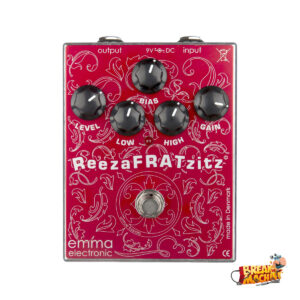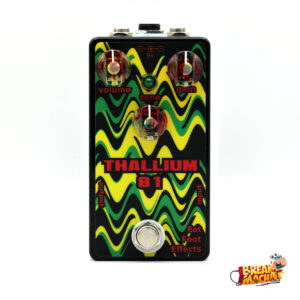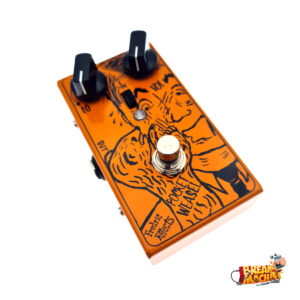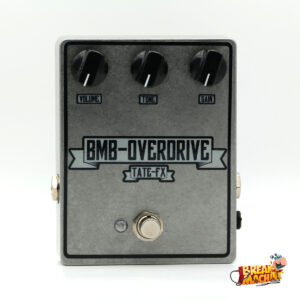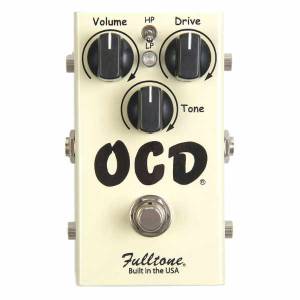Guitar, keyboard and bass friendly USA made boost pedal
Dusky Electronics Mandorla
Coloured Boost
The Mandorla is a boutique colored boost pedal, inspired by vintage treble boost pedals from the ‘60s, with some modern twists.
Current Draw
<10mA
The MOSFET gain stage at the heart of the Mandorla is set up to take full advantage of the delicious non-linearity inherent to MOSFETS for gobs of even order harmonic distortion without clipping to produce a sound not unlike old tweed-era tube amps—clean, but colored. Even with gain set at unity, engaging the Mandorla sweetens and enhances—kind of a “more good” pedal. The Mandorla isn’t just for guitar—it sounds great on bass, keyboard, or any electric instrument.
The Meat knob controls the low end content from the pedal. With this knob all the way down, the voicing is very similar to vintage treble boosters of time immemorial. With the knob all the way up, the Mandorla is a full range booster with tons of low end available. At intermediate settings you can dial in or out just the amount of bass you need to sit in the mix with your bandmates. You might be surprised at how useful getting rid of some bass can be for helping each instrument in your band stand out and be heard.
The More knob controls the output volume—turning it up, there is plenty of clean gain available to drive your tube amp into sweet, musical overdrive.
Here is what the owner of Dusky has to say:
What I love about analog circuit design is that simple circuits can have such complex behaviors. Something like a single tube or a single transistor—in all its classic, nonlinear, imperfect glory—is, at the end of the day, downright complicated in the way it behaves. And it’s those complexities, those infidelities, those inaccuracies in reproduction that make a circuit musical. That’s where the magic happens.
The concept for the Mandorla was to really play to the inherent, delicious nonlinearity of the MOSFET transistor and design a circuit that misbehaves in the most beautiful way possible. The Mandorla doesn’t, on its own, produce clipping distortion, although it can certainly push an amp into overdrive and clipping. The Mandorla does produce a lot of harmonic distortion as a result of its less-than-faithful reproduction of an instrument’s signal, and, in a musical context, this just makes it sound good. It’s the same reason tube amps sound so good.
The Meat knob is a crucial element of the design. The ability to control the bass contour of an instrument’s frequency response gives you the ability to find the perfect spot in the frequency spectrum for your instrument to sit in the overall mix. What some less-experienced guitar players don’t realize is that, in an ensemble setting, turning down the bass frequencies on the guitar can help to make both the guitar and the bass more-discernible in the mix.
When each instrument is occupying its own spot in the frequency spectrum, the result is that the audience can hear more of each instrument in the mix. Of course, with the Mandorla, you can also have a lot of bass, if that’s what you need. In fact, I use the Mandorla all the time on bass. I wouldn’t hesitate to try it on anything.
I guess what I’m most proud of is that such a simple circuit design—with an equally simple two-knob user interface—can sound so good and be so versatile. It really can be used in a lot of different places on a lot of different kinds of instruments. And it really shines in an ensemble setting where every instrument is trying to be heard
SKU: DUSKY#MANDThe 101
The Need To
Know Stuff...

Do you ship to my country?
Most likely, but if we don’t please ask us and we might be able to.
How much is shipping?
Shipping is free in the UK over £199 and for other amounts and deliveries outside the UK, the price calculated at checkout.
When are you going to get the item I want back in stock?
Just click the ’email me’ link at the bottom of the item and we’ll add you to the waitlist.
Do you accept trade-ins?
Yes, from time to time. Send us an email using the ‘Sell Us Your Gear’ clickable link on the red banner at the top of the website homepage.
I'm stuck! and not sure what I need...
Drop us an email or why not try the Random Gear Generator!
Sell Us Your Gear!
Got some old, unloved gear? Tell us all about it using the form below - we might just buy it from you!






